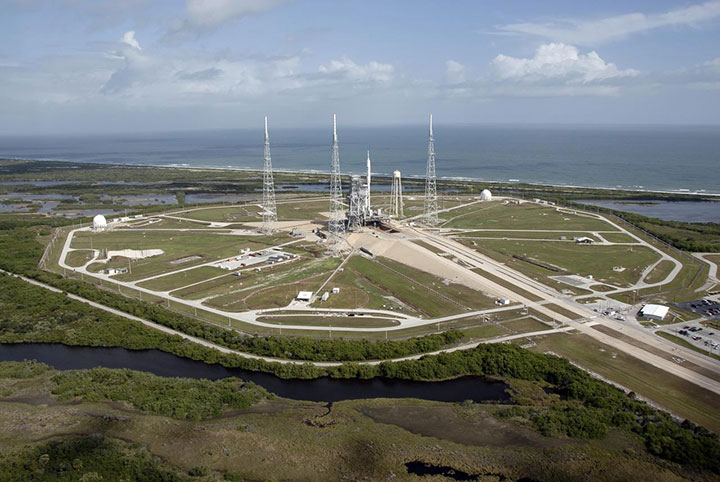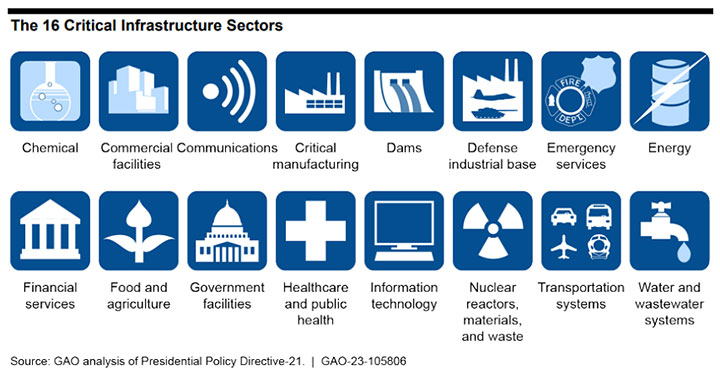 Launch Pad 39B at NASA’s Kennedy Space Center in Florida. (Source: NASA/Kim Shiflett)
Launch Pad 39B at NASA’s Kennedy Space Center in Florida. (Source: NASA/Kim Shiflett)
WASHINGTON — Momentum is building for space to receive a critical infrastructure designation from the U.S. government, driven by the growing importance of space infrastructure and services to the economy and security of the United States. But support for this designation is not unanimous throughout the space sector.
Critical infrastructure sectors “are considered so vital to the United States that their incapacitation or destruction would have a debilitating effect on security, national economic security, national public health or safety,” according to the U.S. Department of Homeland Security. There are 16 such designations, including broadly defined areas such as communications, emergency services, financial services and IT and sectors such as critical manufacturing, the defense industrial base and transportation systems.
Industries that receive the critical infrastructure designation are eligible to receive prioritized cybersecurity assistance and protections from the Department of Homeland Security. The industry becomes a priority within the National Infrastructure Protection Plan, which makes it easier for the federal government to have discussions with key stakeholders regarding sensitive vulnerability information.
The critical infrastructure designation “provides a better system for the engagement of sharing information. It provides a nation with someone responsible for risk management,” said Rear Admiral Mark Montgomery, USN (Ret.), senior director of the Center on Cyber and Technology Innovation at the Foundation for Defense of Democracies and executive director of the Cyberspace Solarium Commission 2.0. “This provides a risk management framework and a system of support and a system of recovery. It’s about preparation, and the cost of preparations is a lot less than the cost of recovery.”
Currently, the various aspects of manufacturing and services associated with space are spread among the existing critical infrastructure sectors, many of which rely on or incorporate space into their operations, but for space advocates, this arrangement is becoming untenable due to the growing use of space infrastructure and services.
“The expansion of space systems, the number of space systems, the complexity of those systems, the number of participants building and operating those systems, and the missions they perform have all grown dramatically in the past few years,” said Samuel Visner, vice chair of the board of Space ISAC and tech fellow with The Aerospace Corp. “There are thousands of satellites as opposed to hundreds. Many other companies are now operating in space and providing commercial services to our critical infrastructure.”
The simplest path to achieve this designation would be for the National Security Council to add space to the list as part of its evaluation and update of Presidential Policy Directive 21 (PPD-21): Critical Infrastructure Security and Resilience. There is also a legislative path. In July, the Space Infrastructure Act was introduced in the U.S. House of Representatives by Reps. Ted Lieu (D-Calif.) and Ken Calvert (R-Calif.), co-chairs of the California Aerospace Caucus, and Reps. Salud Carbajal (D-Calif.) and Brian Fitzpatrick (R-Pa.). The bipartisan legislation directs the Secretary of Homeland Security to designate space systems, services and technology as a sector of critical infrastructure.
While momentum is building, the space sector is not unified in the desire to see space designated as critical infrastructure. In September, the Aerospace Industries Association (AIA) sent a letter to Jake Sullivan, National Security Advisor, urging the National Security Council to conduct a more focused cost-benefit analysis to understand how the designation would affect space systems and the space industry. AIA represents more than 320 suppliers, designers, manufacturers, launch providers and operators of commercial, civil, and national security satellites and space vehicles.
The Sept. 18 letter, signed by Eric Fanning, President and CEO of AIA, expresses concern that the designation could result in additional government regulations falling on the broader space sector. “For purposes of the critical infrastructure designation discussion, space should be considered a domain, like the ocean or airspace, rather than a sector,” the letter said. “This is because many space-based capabilities and their enabling infrastructure are already considered within critical infrastructure sectors, such as the critical manufacturing, communications, defense industrial base, government infrastructure, and transportation systems sectors.”
 The U.S. government has designated 16 sectors as critical infrastructure, enabling organizations within those sectors to receive specific resources. (Source: GAO)
The U.S. government has designated 16 sectors as critical infrastructure, enabling organizations within those sectors to receive specific resources. (Source: GAO)
The difficulty with spreading responsibility for space among existing sectors such as communications, energy and transportation is that none of these areas are prepared to handle the unique requirements of space-related infrastructure and services, said Visner. “I don’t think anybody but the space sector understands the technology of launch or TT&C or ground station or on-orbit operations better than themselves. These are highly technical and specialized endeavors. … Relativity Space is doing 3D printing of rockets. That’s work that exists at the intersection of additive manufacturing and understanding the design of space launch vehicles. That is just something that is not going to be covered elsewhere or not at the extent it needs.”
Visner believes that these other sectors don’t want the increasing responsibility of being responsible for the space sector. “A lot of space systems infrastructure is unique. It provides a lot of support for communications, but the communications sector doesn’t manage the security and resilience of launch infrastructure or of the supply chain or of mission systems. A lot of the adversary activity is unique to space systems and not seen by other sectors, such as RF interference to cause orbital anomalies or collision,” he said. If responsibility for space continues to be divided among sectors, “that’s a blueprint for a failed response.”
Montgomery takes a different viewpoint than the AIA regarding regulations. “One of the reasons we need this is because the U.S. should take the lead on setting norms of space safety and space law,” said Montgomery. “Once we start trying to exploit space for economic benefit, we will wish the U.S. had a strong principled regimen.”
Lack of a designation will mean that in “the short term, companies may make more money,” Montgomery said. “But in the long term, they place themselves at risk. The most important thing is for industry and government to work together on this. It’s about developing relationships and setting standards and understanding what the sector needs.”
Designating space as a critical infrastructure sector will also provide U.S. allies with a singular point of contact for risk management issues, Montgomery said. “We have space relationships, but they tend to be agency or mission driven – intel or DoD or communications. Having a singular sector risk management agency in the U.S. makes it easy for other countries to come in and say, ‘We have this issue,’ and we can point them to where the U.S. would handle it with them. We have seen this with the electricity and financial services sector.”
The space sector will continue to address these issues and continue to improve its risk management approach even if the critical infrastructure designation is not given, Visner said. “We want to make sure that we are heard and the government sees the need for effective risk management. It’s about accountability and active outreach to the sector. If it doesn’t happen, we won’t be worse off than now, but we won’t be any better. I think there is enough discussion and the administration and Congress recognize the importance.”
Explore More:
CISA Identifies 2 Critical Vulnerabilities Used to Exploit Aerospace Sector
Down to Earth: How Non-Space Businesses Are Using Space Tech
Podcast: Digital Service, Building an Open Architecture and the Critical Role of Industry
Starlink Outage Is a Reminder of the Importance of Network Diversity
